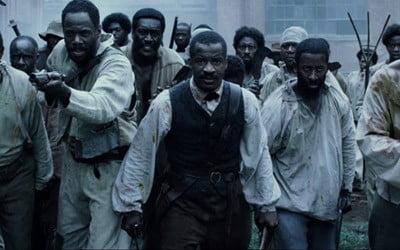El nacimiento de una nación es la obra cumbre de D. W. Griffith, una película muda de 1915 que revolucionó la joven técnica cinematográfica y que contribuyó al resurgimiento del racismo y el odio hacia los negros por su visión romántica del Ku Klux Klan. La película de 2016 toma el mismo título y revierte la historia, narrándonos un pedazo de los estados sureños a principios del siglo XIX, en una historia basada en hechos reales, la vida de Nat Turner, un esclavo negro y predicador que lideró una rebelión.
Conocemos a un Nat Turner de niño, con una especie de amistad con el que después será su amo y, mediante figuras oníricas, atravesamos el tiempo con elipsis bastante amplias, desde su infancia, con los datos que nos permiten saber que el niño lee hasta que lo vemos trabajando en los campos de algodón. Una vez adulto, ese conocimiento de las letras lo lleva a leer la Biblia y convertirse en predicador de sus iguales, cuestión que aprovechan los blancos para que Turner les enseñe y predique obediencia. Pero la agresión a su esposa provoca que cambien las tornas y lo que antes era obediencia, se convierte en odio y así Turner va a liderar una rebelión fallida contra los terratenientes blancos, no sintiendo compasión por nada ni nadie.
No vamos a negar que la película, dirigida e interpretada por Nat Parker, es impresionante. Lo es. Sin embargo, me sorprende su presencia en el Festival de Cine de Gijón, dado que la producción, financiada en 10 millones de dólares, provoca que tengamos más técnica y más efectos casi que historia. No vamos a encontrar nada especialmente nuevo: escenas de acción hollywoodienses, crueldades filmadas para provocar náusea, relaciones previsibles y un final lacrimógeno. ¿La película está bien? Sí, cuando se estrene en el circuito comercial, seguramente se convierta en candidata a los Oscar, parece pensada para ello, sin embargo, en un festival en el que las películas tienen un menor presupuesto y ofrecen cosas distintas, es como haber ido a una sala de cine normal.
Nat Parker está bien en su papel, correcto, sin florituras, al igual que el resto del reparto, con mención especial a Armie Hammer en el papel del esclavista Samuel Turner. La película tiene una fotografía oscura, que tras dos horas se convierte en algo agobiante y, a mi parecer, no tan justificado como se pretende, pero muy a la moda. En cuanto al guion, no sorprende no porque la historia de Nat Turner sea conocida, sino porque el carácter comercial del film provoca que los giros sean los esperados en todo momento.
Las comparaciones son odiosas, pero entre Migas de pan, una historia de represión y dictadura en Uruguay, y The Birth of a Nation, las diferencias a la hora de narrar, visualizar y presentar al espectador, la técnica, basada en el guion y no en los efectos especiales de la cinta uruguaya, le da mil vueltas a la americana.
The Birth of a Nation, Nate Parker (USA). Gijon International Film Festival (Official Section) (English)
Sundance 2016 Official Section. Fox has bought the copyrights for worldwide release. Film released on October 7th 2016.
The Birth of a Nation is the masterpiece of D. W. Griffit, a silent 1915 movie that shook up the young techniques of filmmaking and at the same time contributed to the raise of racism and hate against black people because of its romantic vision of the Ku Klux Klan. The 2016 film uses the same title, but only on behalf of reversing the story, showing us a scene of the Southern states in the early 19th century. The movie is based in real facts: the life of Nat Turner, a black slave and preacher who led a rebellion.
The movie starts with a young Nat Turner who is the friend of Sam Turner, the same person who will be his master in the future. By the mean of dream shapes, we cross though time with ellipses; from his childhood, when we find out that Nat knows how to read to his work in the cotton fields. Once an adult, his knowledge of reading allows him to become a preacher and read the Bible to his peers: an issue that white people use for their own benefit, forcing Turner to teach obedience and docility. But in the process, a white owner rapes Turner’s wife and he starts to turn obedience into hate, a matter that lead Turner to a insurrection against white owners, lacking any compassion even for people who treated him well in the past.
I can’t say that the movie, directed and performed by Nat Parker, is impressive. It is. However, I’m surprised by its presence at the Gijon Film Festival, because production, with a budget of 10 million dollars, made the film more a technical than narrative one. We’re not going to find anything specially new: Hollywood action scenes, cruelties that deliver into nausea, predictable relationships and a tearful ending. But, is this movie good? Sure it is; given the opportunity to watch it on cinemas, it will surely become a serious candidate for the Oscar Awards, because it seems designed for that purpose. However, in a festival where films have a lower budget and offer different things, it’s like going to the cinema with friends in a normal way.
Nat Parker give us a correct performance as the lead role, like the rest of the cast, with special mention to Armie Hammer in the role of the slave owner Samuel Turner. The film has a dark visual style, sometimes justified, sometimes not; but surely overwhelming. The script is not surprising, not only for the common knowledge of Nat Turner’s history, but because the commercial nature of the movie makes all the turnings into expected for the whole movie.
Between Migas de pan, a history about repression and dictatorship in Uruguay, and The Birth of a Nation, differences lie in the way it describes history, point of view and how to show to the public (a technique based on the script, nor in the special effects). In the end, I would say that, the Uruguayan movie is a thousand times better than the American one.
























